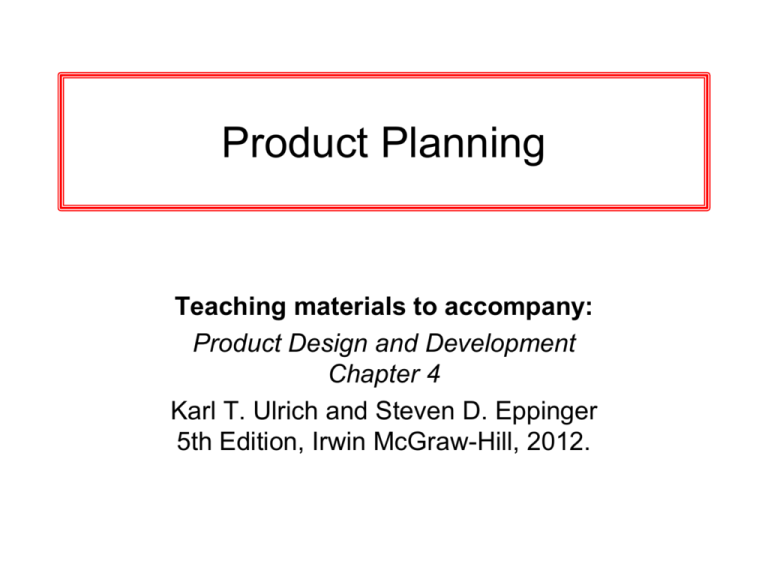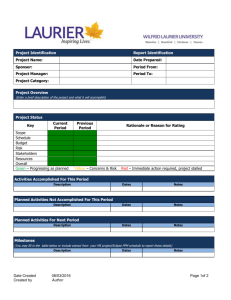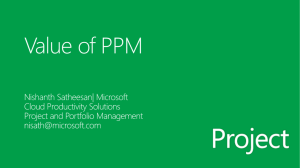Product Strategy
advertisement

Product Planning Teaching materials to accompany: Product Design and Development Chapter 4 Karl T. Ulrich and Steven D. Eppinger 5th Edition, Irwin McGraw-Hill, 2012. Product Design and Development Karl T. Ulrich and Steven D. Eppinger 5th edition, Irwin McGraw-Hill, 2012. Chapter Table of Contents: 1. Introduction 2. Development Processes and Organizations 3. Opportunity Identification 4. Product Planning 5. Identifying Customer Needs 6. Product Specifications 7. Concept Generation 8. Concept Selection 9. Concept Testing 10. Product Architecture 11. Industrial Design 12. Design for Environment 13. Design for Manufacturing 14. Prototyping 15. Robust Design 16. Patents and Intellectual Property 17. Product Development Economics 18. Managing Projects Product Development Process Planning Concept Development System-Level Design Detail Design Testing and Refinement Production Ramp-Up Four Phases of Product Development The product planning phase precedes the product development process. The Product Planning Process Outline • • • • Product Plan Problems with no product plan Project’s Mission Statement Product Planning Process 3/18/2016 5 Product Plan • Portfolio of products to be developed by the organization and the timing of their introduction to the market. • A set of projects approved by the planning process, sequenced in time 3/18/2016 6 Xerox Lakes Project Example Xerox Document Centre 265 A Product Plan Problems with no product plan • Inadequate coverage of target markets with competitive products • Poor timing of market introduction of products • Poor capacity planning and under-utilizing or development resources. • Initiation and cancellation of ill-conceived projects • Frequent changes in project directions. 3/18/2016 9 Four types of product development projects • Fundamentally new products – New product or production technology for new and unfamiliar markets • New product platforms – New products for familiar markets and product categories • Derivatives of existing product platforms – Use existing product platforms to better address familiar markets with new products. • Incremental improvements to existing products – Only add or modify some features of existing products to keep the product line current and competitive 3/18/2016 10 The Product Planning Process Multiple Projects Identify Opportunities Evaluate and Prioritize Projects Portfolio of Projects Allocate Resources and Plan Timing Product Plan Complete Pre-Project Planning Mission Statements Product Development Process Product Planning Questions • What product development projects will be undertaken? • What mix of fundamentally new products, platforms, and derivative products should be pursued? • How do the various projects relate to each other as a portfolio • What will be the timing and sequence of the projects? 3/18/2016 12 The Product Planning Process 1. Identify & select opportunities 2. Evaluate and prioritize projects Product/project portfolio 3. Allocate resources and plan timing Product/project plan 4. Complete pre-project planning Product/project mission statement 5. Reflect on the results and the process. 3/18/2016 13 1. Identify opportunities, from • Marketing and sales personnel • Research and technology development organizations • Current product development teams • Manufacturing and operations organizations • Current and potential customers • Third parties such as suppliers, inventors, and business partners 3/18/2016 14 2. Evaluate and prioritize projects - 2.1 for existing platforms or markets, depend on • Competitive strategy, by focusing on at least one of the following – – – – • Market segmentation – • Divide the market into segments in order to be more focused on the customer and competitors Technological trajectories – • Technology leadership (R&D) Cost leadership Customer focus Imitative (lead time leadership) Consider when to adopt a technology in its S-shape curve of use. Product platform planning – – – Product platform: a set of assets such as components and subassemblies, shared across a set of products in the company Platform development projects may take 2-10 times as much time and money as derivative product development projects Technology roadmap is usually used to represent the expected availability and future use of various technologies relevant to the product being considered. See a roadmap in EX4-7 on page 62. 3/18/2016 15 Market Segment Map 65 ppm 65 ppm network $31k $23k 55 ppm Department $20k Market Segment 40 ppm 60 ppm network $35k Lakes Project $16k 25 ppm $10k 35 ppm $15k Lakes Extensions 40 ppm $20k Legend Xerox product Workgroup 30 ppm $10k 40 ppm network $20k competitor product Hodaka Project 20 ppm $8k 25 ppm $9k potential competitor 30 ppm $10k Personal 20 ppm $7k 1997 1998 1999 2000 Year of Release Copier Performance Technology S-Curves Digital Technology Light-Lens Technology Time Platforms vs. Derivatives Technology Roadmap Functional Elements Technologies Photoreceptor Cylindrical Drum Scanner Layout 2D CCD Array w/Optical Reduc. Toner Type High Temperature Output Modes Monochrome: Paper, Fax, Scan, Local Network, Internet 3-Pitch Belt Photoreceptor n-Pitch Belt Photoreceptor Full-Width, Linear Array without Optical Reduction Low Melting Point Low Melting Point, Low Emission Color: Paper, Fax, Scan, Local Network, Internet User Interface Keypad Touch Screen Image Processing 600 dpi Automatic Image Quality 600/1200 dpi 1200 dpi Diagnostics On-Board Diagnostics Touch Screen, Remote PC Remote-Dialup Diagnostics 1800 dpi Remote Repair Document Centre 220, 230 Document Centre 240, 255, 265 Document Centre 2XX Document Centre 3XX Hodaka Project Lakes Project Lakes Extensions Next Platform Time 2. Evaluate and prioritize projects - 2.2 For new markets or new technologies, consider • • • • • • • • Market size (annual sales x unit price) Market growth rate Competitive intensity (competitors and their strength) Depth of the firm’s existing knowledge of the market. Depth of the firm’s existing knowledge of the technology Fit with the firm’s other products Fit with the firm’s capabilities Potential for patents, trade secrets, and other barriers for competitors to enter • Existence of product champion within the firm 3/18/2016 21 2. Evaluate and prioritize projects - 2.3: balance the portfolio • The choice of competitive strategy affects the product development portfolio • Use of the product-process change matrix to balance the portfolio, as shown in page 63. • Product development is closely coupled with technology development, though it is usually not in the company’s control. 3/18/2016 22 Product-Process Change Matrix Extent of Production Process Changes Extent of Product Changes Research and Technology Development New Core Product Next Generation Product Addition to Product Family Minor Product Enhancement No Product Change New Core Process Next Generation Process Single Department Upgrade Tuning and Incremental Changes No Process Change Breakthrough Development Projects Platform Development Projects Lakes Project Derivative Product Development Current Product/Process Support 3. Allocate resources and plan timing • Every company has finite resources • It estimates resource requirements for each project in the plan by month, quarter, or year. • The resources plan is usually prepared at aggregate level by major resource categories, as shown on page 65 • The effort of resource planning and project timing should also consider: – Timing for product introduction – Technology readiness – Market readiness 3/18/2016 24 – Competition Aggregate Resource Planning 4. Complete pre-project planning • Finalize a mission statement for each project (shown on page 67) that includes – – – – – – A brief (one sentence) description of the product Major benefit proposition Key business goals Primary and secondary markets for the product Assumptions and constraints for the development effort Stakeholders • Sign up key members of the development staff 3/18/2016 27 Project’s Mission Statement 1. Market segments to be considered for the product design and its features. 2. New technologies (if any) to be incorporated into the new product 3. Manufacturing and service goals and constraints 4. Financial targets for the product design 5. Budget and time frame for the project 3/18/2016 28 Lakes Project Mission Statement Product Description Networkable, digital machine with copy, print, fax, and scan functions Key Business Goals Support Xerox strategy of leadership in digital office equipment Serve as platform for all future B&W digital products and solutions Capture 50% of digital product sales in primary market Environmentally friendly First product introduction 4thQ 1997 Primary Market Office departments, mid-volume (40-65 ppm, above 42,000 avg. copies/mo.) Secondary Markets Quick-print market Small ‘satellite’ operations Assumptions and Constraints New product platform Digital imaging technology Compatible with CentreWare software Input devices manufactured in Canada Output devices manufactured in Brazil Image processing engine manufactured in both USA and Europe Stakeholders Purchasers and Users Manufacturing Operations Service Operations Distributors and Resellers 5. Reflect on the result and process 1. Does the opportunity funnel generate good product opportunities? 2. Does the product plan support the firm’s competitive strategy? 3. Does the product plan address the most important opportunities? 4. Does each project core team accept the challenge as stated in mission statement? 5. Are resources sufficient and effectively utilized? 3/18/2016 30




